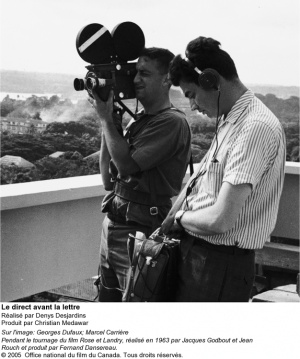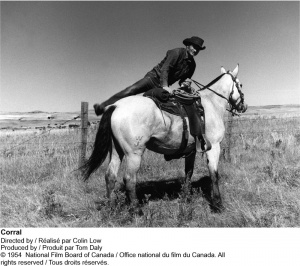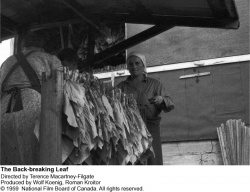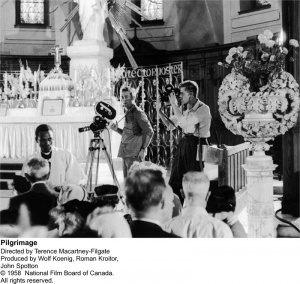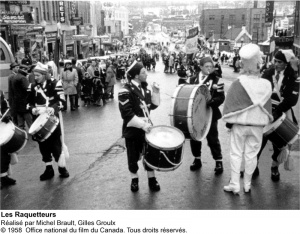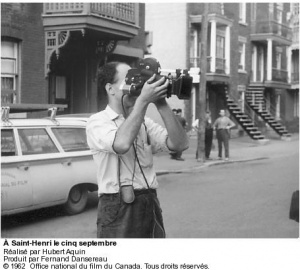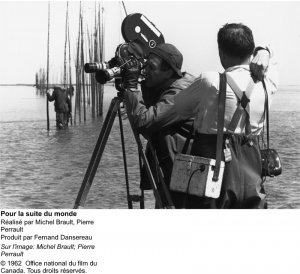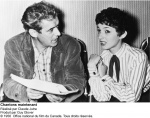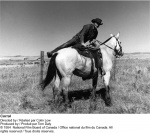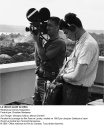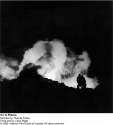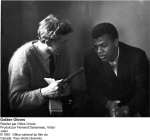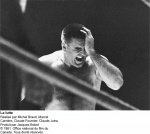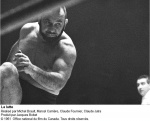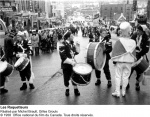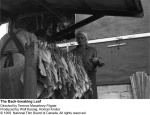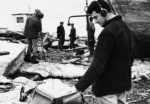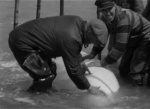Direct Cinema and the National Film Board
par Delisle, Martin
Direct Cinema has had a profound influence on the history of the film industry. With the use of the lighter filming equipment available that became available in the 1950s, documentary filmmakers were able to get closer to their subjects, thereby making their movies much more vivid and personal. In so doing, film producers were able to present their subjects in such a more genuine, realistic light, that the movement has sometimes been called Cinéma-vérité or “truthful cinema”. Filmmakers from the National Film Board of Canada had a significant influence on the development of this particular approach to filmmaking, especially during the late 1950s and throughout the 1960s. The production of major French Canadian films, such as Les Raquetteurs, La Lutte and Pour la Suite du Monde, ensured that Direct Cinema would have an important place in the world of filmmaking. Today, the influence of Michel Brault and Pierre Perrault (some of Direct Cinema’s main architects) is widely recognised. These filmmakers helped establish the movement and left a legacy that has brought filmmaking to new levels of expressivity and which still influences filmmakers around the world today. Their contribution to cinematography is well documented, not only through a profusion of written articles, but also through the collections of films compiled from among the works of the most well known of them.
Article disponible en français : Cinéma direct et l'ONF
A Brief History
The documentary as a form of filmmaking appeared during the early years of cinema. When the Lumière brothers started shooting film in the 1890s, they captured events from everyday life and produced the first filmed reports (e.g. La Sortie de l’Usine Lumière à Lyon and L’Arrivée d’un Train à la Gare de La Ciotat).
Thereafter, two great icons from the world of documentary filmmaking arose. In the newly established Soviet Union, Dziga Vertov (1896 -1954) directed the first filmed newsreels in 1918 and 1919 (which at that time were called Kino-Pravda [Eye-Cinema]). Then, the American explorer Robert Flaherty (1884-1951) became the first to live among and connect with subjects before filming them going about their daily lives. In so doing, he created a style that later became a building block for the “docudrama”. Under the pretext of seeking to document the lives of his protagonists, he sometimes introduced fictional elements to make them more interesting. In this way, Flaherty paved the way for Direct Cinema. Some thirty years later, Pierre Perrault would use this particular technique when he asked the people of the Île-aux-Coudres to re-enact porpoise hunting (Pour la Suite du Monde).
Robert Flaherty would also have considerable influence on John Grierson (1898-1972), a Scotsman who went to Hollywood to study cinema. In 1926, it was he who coined the term “documentary” in his review of Flaherty's movie Moana. He then developed his own filmmaking principles for the genre. In 1929, he returned to the United Kingdom where he directed Drifters, a documentary on the harsh life of herring fishermen in the North Sea. This film was noted for its unique depiction of the workers' lives. Shortly after this film, Grierson stopped directing and, with a group of young filmmakers for whom he would eventually become the producer, he dedicated himself to producing socially oriented films under the auspices of the General Post Office (GPO). This did not however lead him to neglect the aesthetics of filmmaking or the documentary movement that he had helped develop and which would eventually come to play a significant role in the development of British cinema.
Grierson's reputation is such that in 1938, the Canadian government invited him to assess the state of Canadian film production. Based on Grierson's report and recommendations, the government created the National Film Board of Canada (NFB), of which Grierson was appointed first commissioner.
At the NFB, Grierson took charge of information and propaganda distribution. He also took advantage of the war years (1939-1945), in order to instil a sense of belonging and unity among the Canadian people via a series of short documentaries. Films from the Canada Carries On series were broadcast in Canada while the The World in Action series were broadcast in the United-States. Both drew millions of viewers to the cinemas.
In 1945, Grierson left the NFB, as well as an enduring cinematographic legacy. For he had paved the way for the ongoing development of the documentary by putting in place young, competent and active filmmakers; some of which were from the United Kingdom, while others were from various cultural backgrounds from across Canada. In so doing, he had succeeded in building a unique model for film production as a public institution.
After Gierson's departure, filmmakers sought to find their own voice by breaking away from the well-structured documentaries that made use of a narrative thread. Colin Low was one of the first to set himself apart with Corral (1954), a short film about horse training on a farm in Alberta. Low first thought he needed to use long narration to explain the training process, but his producer Tom Daly, who was also involved in editing the film, showed him otherwise. In the film, images are soberly interwoven with the soundtrack composed by Eldon Rathburn, which consists of a series of western melodies for two jazz guitarists. This film also represents a technical turning point. It is the first documentary to be shot with a light camera fixed to a rotating head tripod. Several scenes were shot using a hand-held camera placed on the shoulder of the chief cameraman, Wolf Koenig. This was something that would have been unconceivable with the heavier equipment of earlier years.
The Candid Eye Series
Tom Daly joined the NFB in 1940 and was appointed executive producer of Unit B in 1951. He was surrounded by talented directors and artists, the most significant contributors being Terence Maccartney-Filgate, Wolf Koenig and Roman Kroitor. These filmmaking artists shared the producing, directing, editing and cinematography among themselves. There were also several French Canadians on the team, among them cameramen Georges Dufaux and Michel Brault.
Koenig and Kroitor claimed that their most important artistic influence came from photographer Henri Cartier-Bresson, whose approach involved filming real life in real time. This implied going beyond the newsreel, in attempt to explore reality in depth. They worked with portable equipment for both image and sound, so as to be able to move and turn with more ease.
With the advent of television in 1952, the NFB began producing films solely for the airwaves. The first series, On the Spot, is a string of short documentaries, each one focusing on an aspect of life in Canada. It was followed by the series Perspective, a blend of documentaries and fictional films dealing with contemporary issues in Canada. Each episode was 30 minutes long. The first television series in French were produced later on (e.g. Sur le vif and Passe-partout).
But of all of the series, the one that gained the most recognition as a piece of quality documentary film making was Candid Eye. Totalling thirteen documentaries, each between 24 and 30 minutes, it was broadcast on CBC in the fall of 1958 and 1959. It was the most celebrated series of the NFB because it would come to have worldwide repercussions, both due to its content (which included social documentaries) and the techniques used to film it (mobile camera and an attempt to use synchronized sound).
Cinéma Direct
In 1956, the NFB moved its headquarters to Montreal. A team of French Canadians was assembled as a result of the move. Included were many individuals who had already worked at the NFB, particularly during the filming of the Candid Eye series. Others came from various backgrounds (theatre, radio, television, etc.). These young artists had a perspective of the world that differed from their English-speaking colleagues. They also had a different approach to filming. For example, Michel Brault rejected the telephoto lens used to film people, something his colleagues from Unit B had a habit of using. He favoured a camera with a short focal length, so as to get closer to his subjects and capture the unexpected.
Candid Eye cleared the way for the young filmmakers of the French Canadian team. They drew their inspiration from the series’ documentary approach, which overcame the genre’s obstacles and broke away from its constraints.
However, they wanted to go even further, and so additional innovative differences emerged in the short film Les Raquetteurs (1958), co-directed by Gilles Groulx and Michel Brault. It is considered to be the precursor of what today is known as Direct Cinema. The camera becomes part of the life of the protagonists, as it follows and observes them. The sound engineer, Marcel Carrière, tried to do an initial take with Qlive synchronized sound. The film, which would eventually become undeniable milestone in the history of documentary filmmaking, almost ended up in the trash, due to what the top management of the NFB considered to be poor filming quality. But, in the end, the film came to have profound and lasting impact on filming techniques. For it showed that there truly was no need for musical breaks or pompous narration to tell a story or depict a real-life event. Moreover, in 1960, the film was also awarded a silver medal by Italian Radio during the Dei Populi Festival (an international social documentary festival) in Florence.
This new way of shooting film offered the young filmmakers of the French language film crew the means to free themselves from the institutional rigidity of the NFB—which, for them, would remain the National Film Board of Canada for a long while thereafter. This was largely due to the fact that they felt that the Board’s filming techniques were outdated and restrictive. They were not interested in Canada as the centrepiece and the focus of numerous films documenting its beauty, parks, and mythology. They wanted to get closer to the people and create connections that the audience would be able to feel beyond the screen and the cinema. Moreover, they expressed their desire to share through film more about the French Canadian folks from their own backyard. And so the concept of nationalist “Quebec” cinema began to take shape. The struggle with the NFB's administration (which was largely English speaking at the time) was not resolved smoothly. When they submitted a film project, a clearly written English script and screenplay were required, although only a synopsis with brief technical instructions was enough for the young filmmakers. Bit by bit, they worked hard to make a place for themselves and their own brand of cinema. This unique approach to filmmaking struck a chord with them and inspired them to fully explore its potential, both on a material and technical level. The aesthetic, historical and political significance of this filmmaking movement would not be fully understood until much later.
Thus, after Les Raquetteurs came a string of films created for television that featured various aspects of life in Quebec; these films began to offer a close-up portrayal of the province's inhabitants, which had never been shown on screen before. Among these films some of the most notable are: La Lutte (Claude Jutra, Claude Fournier, Marcel Carrière, Michel Brault, 1961), Golden Gloves (Gilles Groulx, 1961), À Saint-Henri le 5 Septembre (Hubert Aquin, 1962) and Bûcherons de la Manouane (Arthur Lamothe, 1962). They were a far cry from the sweetened and sanitised version of life in Canada portrayed in previous films presented by the National Film Board.
At the same time, the French-speaking film crews attempted to push the technical limits of filmmaking, because screenplays for the genre required light and easy-to-handle equipment. Extensive research was carried out with the objective of developing a camera that could sit on a camera operator's shoulder and operate in conjunction with a tape recorder, so as to make it possible to synchronize live image and sound. Although Michel Brault lead the research, others also contributed on various levels: a few of the cameramen from the Candid Eye series; Jean Fouch, French ethnologist and filmmaker; Raoul Coutard, the chief cameraman from Godard's earliest films; as well as documentary filmmaker Richard Leacock.
It was at film festivals and documentary seminars that viewers from around the world would discover this unique brand of cinema. This is how Michel Brault met Jean Rouch in 1959. They recognised in each other a shared vision for filmmaking and their desire to film life as it is. From this emerged a collaborative relationship between the two men that led them to shoot a film together in Africa and then to collaborate on Chronique d'un Èté (1961). It was during the shooting of the second project that Brault tested a new camera upon Rouch's request.
This new approach to cinematography made it possible for Pierre Perrault to film research on the speech of the people living on Île-aux-Coudres. In 1962, with Brault working as co-director, he undertook the shooting of the first Direct Cinema-style, feature-length documentary, Pour la Suite du Monde. For the film, he asked fishermen of the island to re-enact the annual porpoise hunt as they used to do up until 1924. To really integrate themselves with the people they wanted to film, the small team lived on the island and shared in the day-to-day lives of the islanders. This enabled the locals to grow accustomed to the filmmakers' presence who, in turn, learned more about their subjects. In this way, they were able to identify and focus on those who were best suited being filmed. The film would not have been possible without the use of a hand-held camera connected to a portable tape recorder. They could not have captured (with such efficiency) the intense poignancy of each moment of life through the eyes of the islanders, as well as the spontaneity of the various exchanges between them. It is precisely these qualities that make Pour la Suite du Monde on of the world’s key works of the documentary genre. And the film is certainly what earned the NFB’s French-speaking team worldwide fame (NOTE 1).
The Legacy
From 1962 on (mostly between 1964 and 1966), some of the most talented filmmakers to have participated in the development of Direct Cinema left the NFB. Over the years, many would return, but only as independent filmmakers working on a specific film. Some continued to work on documentaries while others turned to the fiction genre. Some would even alternate between documentaries and fiction.
Many of these filmmakers have had a positive impact on Canada, as well as Quebec’s cultural heritage through the making of major films that continue to entertain viewers and to offer film amateurs material for study. Access to these works has become easier since the NFB compiled the works of several of these artists in DVD box collections. The complete works of Pierre Perrault are now available in five amply commentated box sets.
Due to their bold approach to filmmaking—both in the material filmed and the techniques used—Brault, Fournier, Godbout, Jutra, Perrault and others have long been a source of inspiration and motivation for young filmmakers. Still today—both in Canada and abroad—a new generation of filmmakers lay claim to this great documentary tradition and attempt to experiment with and contribute to this movement in their own unique way. Not only is the legacy of Direct Cinema considerable, but also, several works from the movement should be treasured as an integral part of French-speaking Canada’s cultural heritage.
Martin Delisle
Consultant, for filming content and programming
NOTES
1. All of the NFB films mentioned in this article can be viewed on the NFB's web site at http://www.nfb.ca
BIBLIOGRAPHY
Backhouse, Charles F., Canadian Government Motion Picture Bureau 1917 – 1941, Ottawa, Canadian Film Institute / Institut canadien du film, 1974, 44 p.
Lever, Yves, Histoire générale du cinéma au Québec, Montreal, Les Éditions du Boréal, 1995, 636 p.
Marsolais, Gilles, L’aventure du cinéma direct revisitée, Laval, Les 400 coups, 1997, 351 p.
Sadoul, Georges, Histoire du cinéma mondial, Paris, Éditions Flammarion, 1979, 531 p.
Patenaude, Michel, Entretien avec Wolf Koenig, La revue de la Cinémathèque, September-October 1994
“John Grierson”, The Canadian Encyclopedia, web site http://www.thecanadianencyclopedia.com/index.cfm?PgNm=TCE&Params=f1ARTf0003457
“The 1950s: Television and the Move to Montreal”, Albert Ohayon, http://www.nfb.ca/playlists/albert_ohayon/1950s-national-film-board-television-and-move/
“Le cinéma direct à l’ONF ou la consolidation de l’équipe française”, Marc St-Pierre http://www.onf.ca/selections/marc_st-pierre/le-cinma-direct-lonf-ou-la-consolidation-de-lquipe/
Additional DocumentsSome documents require an additional plugin to be consulted
Images
-
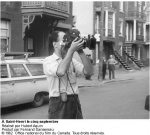 À Saint-Henri le cinq
À Saint-Henri le cinq
septembre -
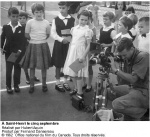 À Saint-Henri le cinq
À Saint-Henri le cinq
septembre -
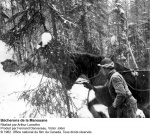 Bûcherons de la Manou
Bûcherons de la Manou
ane -
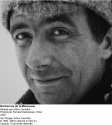 Bûcherons de la Manou
Bûcherons de la Manou
ane
-
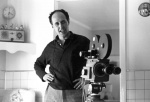 Marcel Brault dans le
Marcel Brault dans le
tournage de Po... -
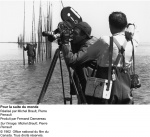 Michel Brault et Pier
Michel Brault et Pier
re Perreault au... -
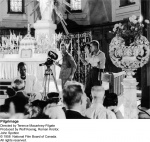 Pilgrimage (Candid Ey
Pilgrimage (Candid Ey
e) -
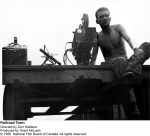 Railroad Town
Railroad Town

